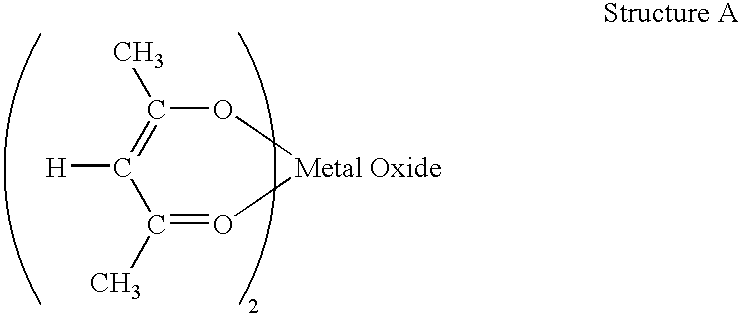Multiple function graft polymer
a polymer and multi-functional technology, applied in the field of multi-functional function graft polymers, can solve the problems of shortening the effective life of automotive emission catalysts, affecting other characteristics, and adding costs
- Summary
- Abstract
- Description
- Claims
- Application Information
AI Technical Summary
Benefits of technology
Problems solved by technology
Method used
Image
Examples
example 1
[0085]A 500 gram polymer solution sample was prepared in the following manner. The polymer Polimeri Europa CO-043 having a molecular weight of about 100,000 was diluted to 12.50% by weight in Exxon EHC-60 base oil and dissolved with heat and agitation. The mixture was then heated to 170° C. with a CO2 purge over the surface of the reaction mixture. At this time the 0.50% by weight of 1-vinylimidazole (VIMA BASF Corp.) was added to the polymer mixture over a 60-minute period. Simultaneously to the VIMA addition, 0.30% by weight of di-t-butyl peroxide (DTBP Aldrich Chemical #16,8521-1) was added over a 60-minute period. Upon completion of the DTBP addition, the reaction was allowed to mix for 30 additional minutes. This reaction was followed by a second reaction.
[0086]This reaction began by heating and / or maintaining the reaction product of part (a) to or at 170° C. To the product of (a) was added 0.50% by weight of molybdenum acetylacetonate (Mo AcAc) (Gelest Inc. #-AKM550). This was...
example 2
[0088]A 500 gram polymer solution sample was prepared in the following manner. The graft polymer, Polimeri Europa CO-043 was diluted to 12.50% by weight in Exxon EHC-45 base oil and dissolved with heat and agitation. The mixture was then heated to 170° C. with a CO2 purge over the surface of the reaction mixture. At this time the 0.50% by weight of 1-vinylimidazole (VIMA BASF Corp.) was added to the polymer mixture over a 60-minute period. Simultaneously to the VIMA addition, 0.30% by weight of di-t-butyl peroxide (DTBP Aldrich Chemical #16,8521-1) was added over a 60-minute period. Upon completion of the DTBP addition, the reaction was allowed to mix for 30 additional minutes. This reaction was followed by a second reaction.
[0089]At this time 0.50% by weight of molybdenum acetylacetonate available from Gelest Inc. (#-AKM550) was added to the polymer mixture over a 1 minute period and allowed to mix thoroughly. After the monomer was incorporated to the reaction mixture, 0.30% by wei...
example 3
[0091]A 500 gram polymer solution sample was prepared in the following manner. The polymer Polimeri Europa CO-043 was diluted to 12.50% by weight in Exxon EHC-60 base oil and dissolved with heat and agitation. The mixture was then heated to 170° C. with a CO2 purge over the surface of the reaction mixture. At this time the 0.50% by weight of molybdenum acetylacetonate available from Gelest Inc. (#-AKM550) was added to the polymer mixture over a 1-minute period. The Moly AcAc was allowed to mix thoroughly into the VII solution. To the VII Moly AcAc solution was added 0.30% by weight of di-t-butyl peroxide (DTBP Aldrich Chemical #16,8521-1) over a 60-minute period. Upon completion of the DTBP addition, the reaction was allowed to mix for 30 additional minutes.
[0092]The resulting product contained the viscosity index improver graft polymer of the present invention.
PUM
| Property | Measurement | Unit |
|---|---|---|
| polydispersity | aaaaa | aaaaa |
| polydispersity | aaaaa | aaaaa |
| polydispersities | aaaaa | aaaaa |
Abstract
Description
Claims
Application Information
 Login to View More
Login to View More - R&D
- Intellectual Property
- Life Sciences
- Materials
- Tech Scout
- Unparalleled Data Quality
- Higher Quality Content
- 60% Fewer Hallucinations
Browse by: Latest US Patents, China's latest patents, Technical Efficacy Thesaurus, Application Domain, Technology Topic, Popular Technical Reports.
© 2025 PatSnap. All rights reserved.Legal|Privacy policy|Modern Slavery Act Transparency Statement|Sitemap|About US| Contact US: help@patsnap.com

